Research Groups
Department of Interaction of Radiation with Matter
Centro Atómico Bariloche
The first laboratory in Argentina dedicated to Atomic, Molecular and Optical (AMO) Physics was created in 1960 by Prof. Wolfgang Meckbach. It is located at the Bariloche Atomic Centre (CAB) and depends on the National Atomic Energy Commission (CNEA). Today, the “Department of Interaction of Radiation with Matter” (DIRM) includes three divisions in AMO Physics, Fusion Research and Surface Science.
Atomic, Molecular and Optical Physics Division
The theoretical research [1–3] cover the study of ionization and fragmentation processes of atomic and molecular systems by the impact of electrons, positrons, ions, protons, photons and intense laser pulses. It includes:
- The development of models to analyze collisions of ionic, electronic and photonic projectiles with atomic and molecular targets using Continuum Distorted Wave (CDW), Monte Carlo Classical Trajectory (CTMC) and ab initio methods, which cover practically the entire range of low to high (non-relativistic) energies of the projectile;
- The calculation and analysis of multiple differential ionization cross sections;
- The optimization of cross section calculations employing GPU (Graphics Processing Unit);
- The study of photoionization of atoms and molecules in intense laser fields (multiphoton ionization, multicolor ionization, above threshold ionization, laser assisted photoionization, etc.)
The experimental research covers the investigation of electronic emission and molecular dissociation by ion beam impact on atomic and molecular targets [4–5]. Its experimental facilities include a 1.7 MeV Tandem accelerator with PIXE, RBS, ERDA and channeling capabilities, and a chamber for Cold Target Recoil Ion Momentum Spectroscopy (COLTRIMS).
Tandem Ion Accelerator
The laboratory is based on a Tandem ion accelerator with maximum terminal voltage of 1.7 MV, model 5SDH from National Electrostatics Corp. (NEC, USA). Single charge ions up to 3.4 MeV and doubly charged ions up to 5.1 MeV energies can be obtained. The injection system has two ion sources, a radio-frequency ion source (Alphatross) mainly to obtain helium ions, and a cesium sputtering ion source (SNICS II) to produce protons and a large variety of heavy ions.

At the accelerator output, after a magnetic selector, there are two beam lines. One is dedicated to material analysis and ion implantation, with micro-beam capability, and a NEC RC43 chamber.
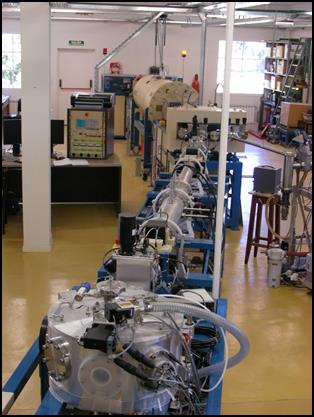
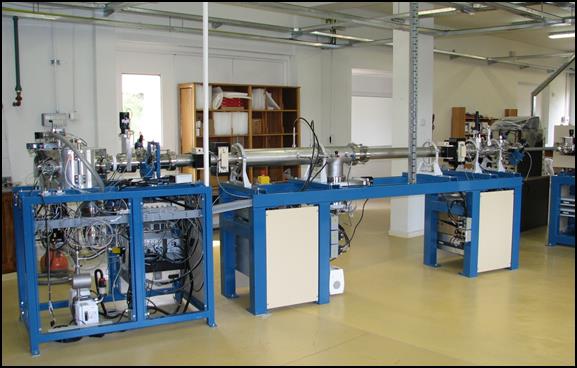
The available ion beam techniques are:
- Particle Induced X-ray Emission (PIXE, characteristic x-rays detection);
- Rutherford Backscattering Spectrometry (RBS, elastically scattered ions detection in backward angles);
- Elastic Recoil Detection Analysis (ERDA, recoiled target nuclei detection);
- Nuclear Reaction Analysis (NRA, gamma-rays detection).
This system is also available for studies using channeling techniques in crystal samples and also for material modifications by ion implantation. In the near future we will incorporate a Wavelength Dispersive X-Ray Spectroscopy (WDS) facility.
These techniques have found many applications for the compositional and structural characterization of samples. Research fields included geology, mineralogy, biology, medicine, environmental science, archeology, forensic science, nanotechnology and others. Different results obtained with the present setup are displayed in the following figures (see references).
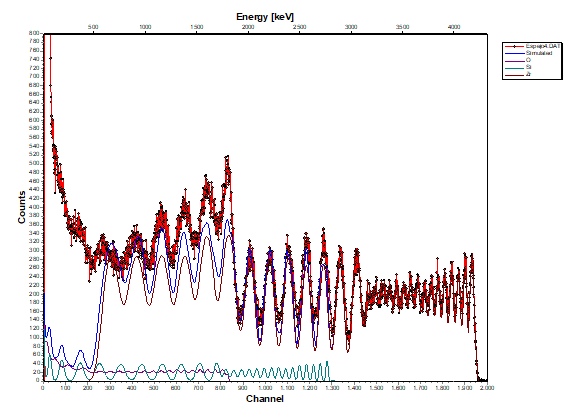

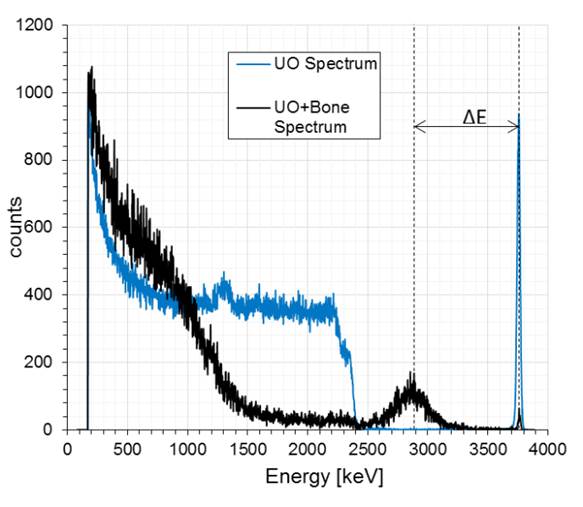
There is also a beam line, manufactured locally, dedicated to research on electronic emission in ion-atom and ion-molecule single collision conditions, and to molecular fragmentation by ion impact. A cylindrical mirror spectrometer, which allows the detection for the full range of emission angles, is the main instrument of this setup. An additional set of detectors record the projectile final charge state, so coincidence measurements between electrons or recoil ions and projectile charge change process can be measured.
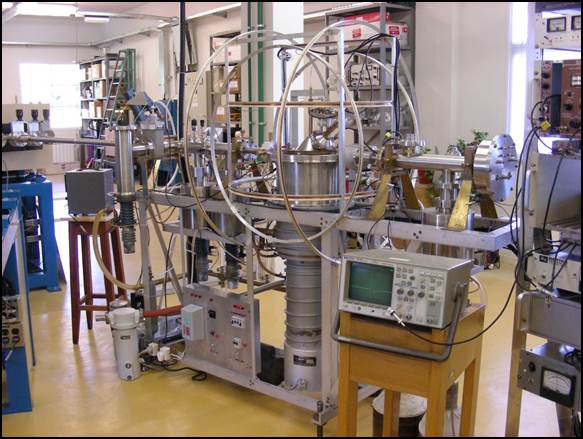
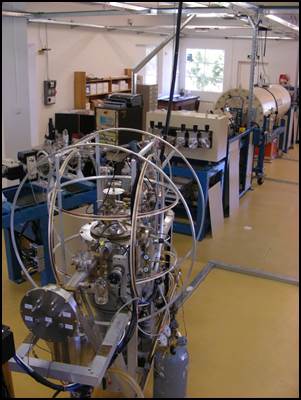
The following figures show some of the results obtained with this setup. They are related to electron emission in Li ions collisions with He atoms, and water fragmentation induced by the impact of dressed ions.
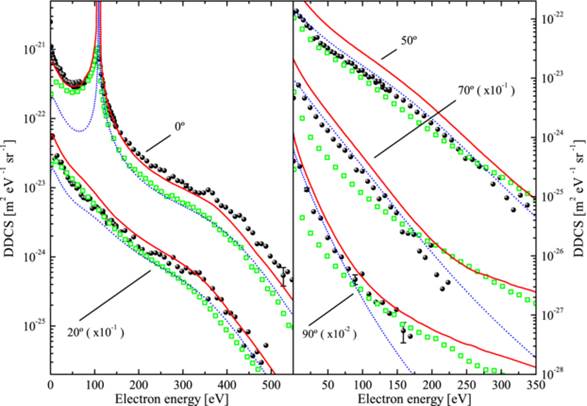

Low Energy 30-keV Ion Accelerator
With a Penning type ion source, this instrument was manufactured locally.
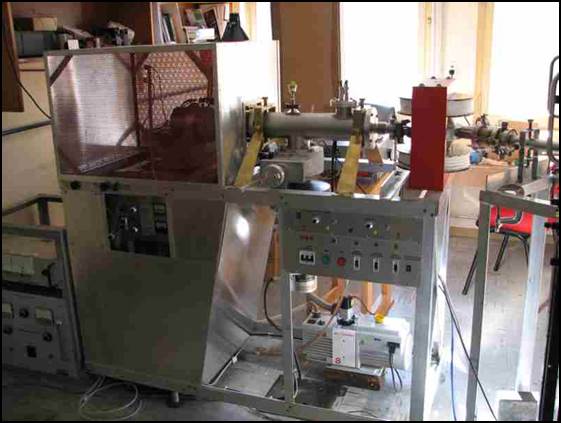
Kevatron accelerator
The laboratory is equipped with a Cockcroft-Walton machine with a maximum accelerator potential of 300 kV.
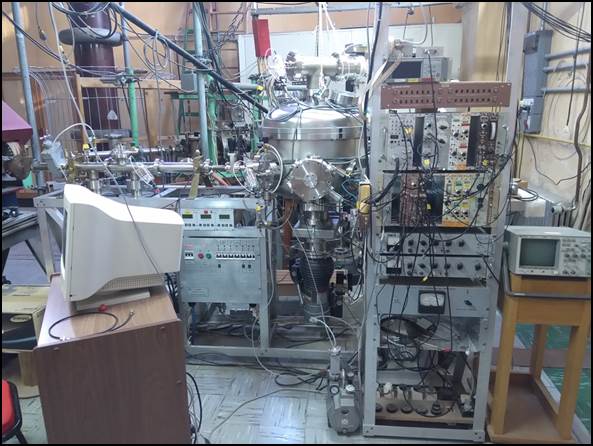
There is an experimental facility based on the cold target recoil-ion momentum spectroscopy (COLTRIMS) technique, as shown in the following figures. This facility is capable of determining the three dimensional momentum distributions of different fragments resulting from an atomic collision. It is applied for study of electron capture reactions and molecular fragmentation processes in our laboratory [11–14].

With the present setup we can perform studies:
- Recoil ion momentum spectroscopy, applied to study projectile charge exchange processes.
- Molecule fragmentation induced by atomic collision.
Some of the results obtained with this setup are displayed in the following figures.
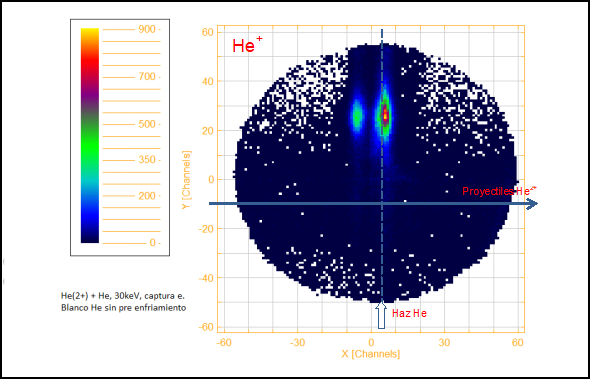
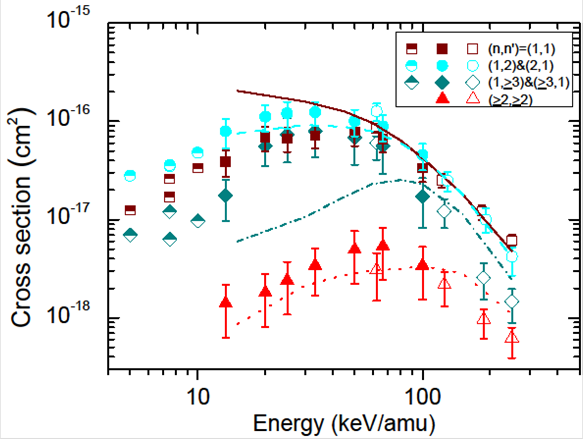
Contact
Raúl BARRACHINA
Group Website
References
- [1] J. M. Randazzo et al., "Double photoionization of helium: a generalized Sturmian approach", The European Physical Journal D 69, 189 (2015).
- [2] J. M. Randazzo and A. Aguilar-Navarro, "Three-body molecular states of the LiH2+ system in the Born-Oppenheimer approximation", International Journal of Quantum Chemistry 118, e25611 (2018).
- [3] R. Della Picca et al., "Nonconstant ponderomotive energy in above-threshold ionization by intense short laser pulses", Physical Review A 93, 023419 (2016).
- [4] N. Cariatore et al., "Water fragmentation induced by ion impact: Fragment-ion-energy determination at different ZP/v regimes", Nuclear Instruments and Methods in Physics Research Section B: Beam Interactions with Materials and Atoms 408, 198-202 (2017).
- [5] M. Alessi, S. Otranto and P. Focke, "State-selective electron capture in 3He2+ + He collisions at intermediate impact energies", Physical Review A 83, 014701 (2011).
- [6] M. Mayer, "SIMNRA, Max-Planck-Institut für Plasmaphysik (Garching, Germany)", [missing journal] .
- [7] "GUPIX, v. 2.1 rev. 360. Copyright (C) 2005. University of Guelph, Canada.", [missing journal] (2005).
- [8] L. Provenzano et al., "Measuring the stopping power of α particles in compact bone for BNCT", Journal of Physics: Conference Series 583, 012047 (2015).
- [9] J. M. Monti et al., "Experimental and theoretical results on electron emission from helium by the impact of bare Li3 ions", Journal of Physics B: Atomic, Molecular and Optical Physics 45, 145202 (2012).
- [10] J. M. Monti et al., "Electron emission in collisions between dressed Alq+ ions with He targets", Journal of Physics: Conference Series 488, 012041 (2014).
- [11] M. Alessi, S. Otranto and P. Focke, "COLTRIMS Experiments on State-Selective Electron Capture in Alpha-He Collisions at Intermediate Energies", Fast Ion-Atom and Ion-Molecule Collisions, 27-54 (2012).
- [12] M. Alessi, D. Fregenal and P. Focke, "Recoil-ion momentum spectroscopy applied to study charge changing collisions", Nuclear Instruments and Methods in Physics Research Section B: Beam Interactions with Materials and Atoms 269, 484-491 (2011).
- [13] M. Alessi, P. Focke and S. Otranto, "Recoil-ion momentum spectroscopy for He2+ + He electron capture reactions", Journal of Physics: Conference Series 583, 012015 (2015).
- [14] P. Focke et al., "Role of the recoil ion in single-electron capture and single-ionization processes for collisions of protons with He and Ar atoms", Physical Review A 95, 052707 (2017).